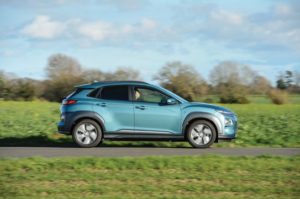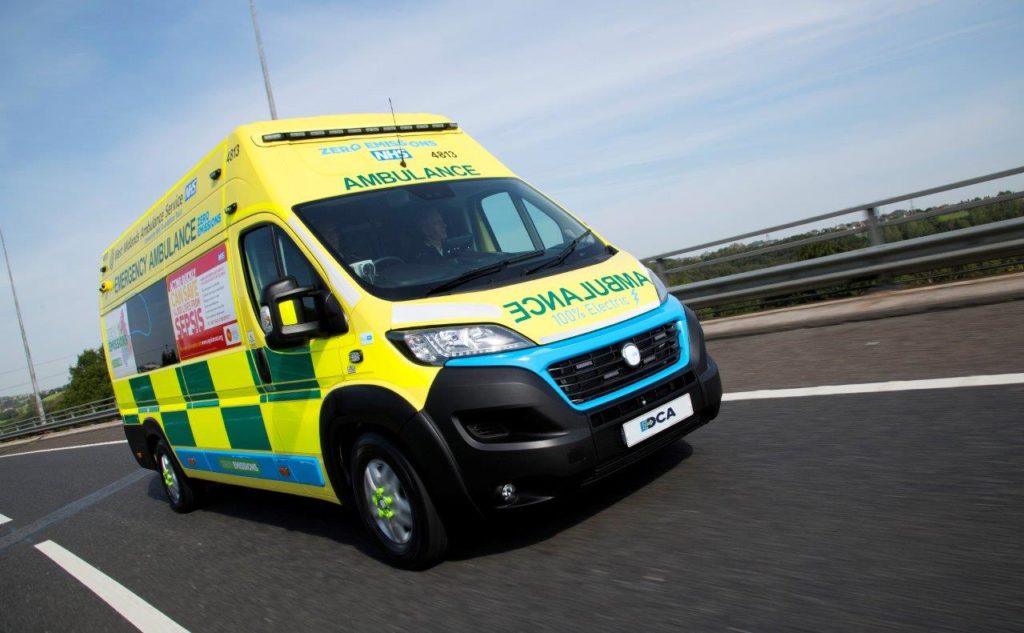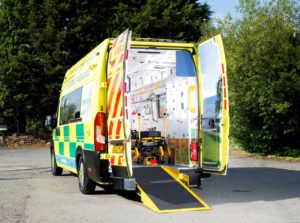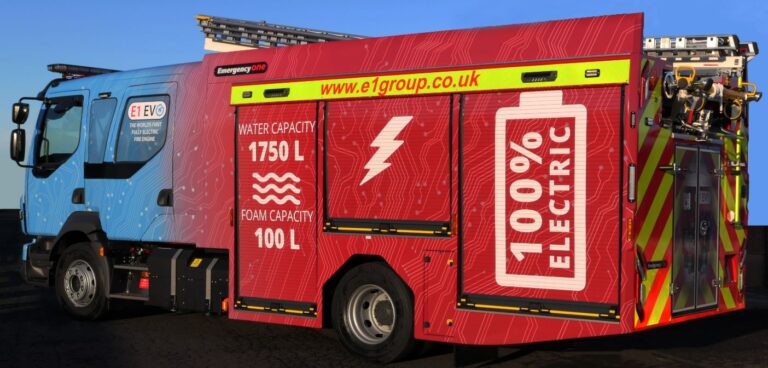Could emergency service vehicles prove pivotal in the UK meeting its emission-reduction and climate targets? Katie Searles finds out why blue light fleets are emerging as forerunners in the transition to electrification…
As the UK works towards the government’s 2030 ban on the sale of all new fossil-fuel cars and vans, recent reports have claimed that fleets will be pivotal in achieving zero-emission road vehicle targets. One sector that could prove key to this are emergency services, which are putting plans in place and trialling fully electric response vehicles.
For example, Police Scotland has set out its ambition to be the first emergency service in the UK to have an ultra-low emission vehicle (ULEV) f leet by 2030. In fact, it has already begun switching unmarked petrol and diesel cars for 180 Hyundai Kona Electric 64kWh vehicles. Also, north of the boarder, in Cumnock, Emergency One, a manufacturer of specialist fire and rescue service appliances, has developed the world’s first electric fire engine.
In England, Bradford-based Vehicle Conversion Specialists (VCS) has created the UK’s first fully electric ambulance. The Electric Dual Crewed Ambulance (E-DCA) has been used in front-line emergency situations by West Midlands Ambulance Service since October 2020. VCS’s managing director, Mark Kerrigan, explains that, in the switch to EVs, somebody had to be the one to make the first step, not because that is what policy makers want, but because he believes “diesel is finished ”.
Indeed, the evolution of battery technology has opened up opportunities for both the developers and users of electric emergency service vehicles, as Steven Bell director of Emergency One, explains: “Battery technology and indeed motor technology has moved on dramatically over the last few years. We now see this technology used by almost every car manufacturer along with more and more commercial suppliers.
“For years we have had electric technology in buses and other heavy-goods vehicles, all of which have the capability to power these vehicles. We have developed this further for the bespoke use in a fire appliance, to meet and exceed the operational needs of fire and rescue services.”
Electric benefits
According to VCS’s Kerrigan, the power that a battery provides an EV grants more than just environmental benefits. Instant torque enables the E-DCA to go from 30mph to 60- or 70mph “frighteningly fast”, thereby helping to improve emergency services’ rapid response times. It has also led some other surprising advantages, says Kerrigan, with patients having commented that the electric ambulance provides a smoother ride and is noticeably quieter. No moving mechanical parts equates to no sound externally and a 20% drop in decibels inside the cabin.

For Police Scotland, a major plus for switching to EVs is the reduced time and money spent on fleet vehicle maintenance. Not only do EVs produce significantly fewer CO2 emissions, but they also spend less time in the garage. As such, Police Scotland predicts it will save just under half of its maintenance bill and use that money on other services.
“The maintenance reduction is really important because we won’t be taking vehicles off the road as much as we are at the moment,” says Stewart Taylor, Police Scotland’s fleet manager.
“We will be doing much more of a localised repair function and, in years to come, can include remote repairs. It is really going to have a positive impact on operations.”
As will batteries, which are getting lighter and becoming increasingly power dense, offering greater extended ranges, shorter charge times and, in some instances, wireless checking of charge levels. VCS’s Kerrigan says he hopes that, by the end of this year, the company’s system will enable full charging of an ambulance in two hours, down from the current charge time of four hours. Police Scotland also understands that technology advancements open up further opportunities for introducing EVs to its response fleet, albeit only “when the product is ready”, which it believes will be from 2025.
When developing its fleet strategy, Police Scotland soon realised that it made no sense to build its EV capability in isolation of anybody else, let alone its emergency services partners. As such, deputy chief officer David Page, who has executive responsibility for corporate services, strategy and change, invited Scottish Fire and Rescue services and Scottish Ambulance services to form part of a blue light collaboration group.
Working as part of a progressive programme of EV deployment, Scotland’s emergency services are able to assist in the wider public sector’s shift to low-emission vehicles. According to Page, by working with partners, lessons learnt can be shared and, if a transparent approach to the pivot to EVs is adopted, blue light f leets even can act as forerunners. “There is a leadership component there for policing moving all vehicles to ULEVs,” he says.
“If we are early movers and we do it in an environmental and economical way, as safely and carefully as possible, and with good engagement and good communication with others, it can actually have a wider impact on communities and decarbonisation efforts across the whole of the UK.”
Building an evidence base of EV technology is something VCS champions. Through its trial with West Midlands Ambulance Service, findings will be published and validated by an independent party. Kerrigan admits VCS’s first electric ambulance is not perfect and does not suit all applications, however he believes data provided by West Midlands Ambulance Service and an open communication approach will enable the manufacturer to iron out any issues for future vehicles.

He’s also calling for more opportunities to test the vehicles in real-world scenarios as he believes this is fundamental in accelerating the move to EVs. “Ultimately, I would like to see the government allow every NHS Trust in England, Scotland, Northern Island and Wales to trial one electric ambulance. “The government goes on about needing electric vehicles, but it needs to start supporting the Trusts and start supporting the converters who can offer this technology. It is home-grown technology, it is not imported, it is ours, it’s this nation’s technology.”
Confidence shift
It is through trials and the testing of electric emergency service vehicles on UK roads that Kerrigan believes will build the public’s confidence in their deployment.
Police Scotland’s Page agrees this is an essential part of the process: “One of the really key things with ULEVs is the cultural acceptance and the transition of operational police officers to be able to get into an electric response vehicle and have full confidence that it will do the job that we need it to do.
“The public needs the confidence that we’re not just transitioning to ULEVs because it is a green government goal. The most important thing for the public is that police officers can do their jobs, that we can respond to cries for help and that we can respond very rapidly to crimes in progress. The biggest driver for our f leet is that the vehicles themselves can do the job.”
Page’s colleague Taylor says he has seen the cultural shift happening “slowly but surely” through feedback from user groups set up. “When you get somebody to drive an electric vehicle, they can immediately see the difference. It is a really nice drive now compared to some of the older diesel vehicles.”
Kerrigan has received similar positive feedback from two chief paramedics at West Midlands Ambulance Service: “They wanted to put it into front line service the day it arrived. That was a great comment to make about the vehicle.”
Additionally, interest in Emergency One’s electric fire engine has spread beyond the UK. The company’s managing director, Mike Madsen, says: “The response of our launch has been on a global scale with customers from many different locations asking to see 2021more details on the vehicle and indeed how we can work with them to create their bespoke solution to integrate EV solutions into their f leets. “We have no doubt that, as the world moves to try a greener and cleaner environment, this will impact all aspects of life and indeed this will see more and more future generations of vehicles being zero emissions. We want to be at the forefront of this technology for our customers, and firmly believe we are.”
Supporting infrastructure
Whilst vehicle electrification is inspiring its users, a concern shared by operators when electrifying blue light fleets is the infrastructure to support it.

As well as grid capacity, there is a question of priority of access to charging stations and Police Scotland’s Page questions what would happen if an emergency response vehicle could not access a charging hub were civilian vehicles using them. Would marking some charge-points for emergency services only be a viable option? “If we are going to put charging points in Scotland, then the very first part of that would be for us to ideally share them with our blue light colleagues,” says Page.
“How do we do that in a way that is sympathetic to local communities? We are continuing to explore how we can better work together to share resources but protect the integrity of the blue light response service.”
The availability of charging hubs and the necessary power to charge EVs is particularly challenging in rural areas. Page adds: “Grid capacity is probably the biggest issue. You are okay running between the big cities and up the central spin of Scotland through cities such as Dundee, Perth and up to Aberdeen. But the moment you become more rural, the grid capacity doesn’t exist.
“If I want to operate a police fleet of those types of vehicles in such geographical areas, it brings its own challenges. And that is not a challenge that Police Scotland can meet, that is a government level challenge.”

Kerrigan agrees that the government needs to “invest heavily” in infrastructure as, without this, vehicle range anxiety remains a real concern. “Let’s say you have an ambulance that needs to travel from London to Scotland, with a neonatal patient. It won’t be travelling very fast and will get stuck in traffic for five to six hours.
“Whilst you could have the same issue with a diesel vehicle, someone can come along and fill the vehicle up with diesel if necessary. It is very hard to bring an electric range charger from the depot to the motorway.”
According to Kerrigan, VCS has tried to remedy this issue with its technology. The E-DCA is fitted with a system featuring regenerative power. When a driver takes their foot off the accelerator it acts like a brake in reverse, slowing the vehicle down whilst throwing energy back into the batteries.
Still, each organisation and supplier agree that the challenge of electric vehicle charging infrastructure is not one that they alone can resolve. They’re unanimous that the issue circles back to funding and the adoption of EVs can only be rolled out as fast as government-funded national infrastructure is rolled out in front of it.
Emergency One’s Madsen concludes: “We are still not fully there but the journey has begun and, with the increasingly personal and cultural desire for individuals to make a real change, as well as organisationally, we believe that we are heading in the right direction.”
Am-bus-lances come to London
It’s not just traditional emergency service vehicles that are embracing electrification to better aid society. Bus company Go-Ahead has loaned a number of its electric single-decker buses to the London Ambulance Service to be converted into makeshift ambulances to relieve Covid-19 related pressure.
According to The Guardian, the repurposed buses will be able to carry four patients following the removal of the majority of seats. The buses will feature oxygen on board and will be used for transferring patients to hospitals including the Nightingale field hospital at the ExCel.
Go-Ahead will provide four drivers for the vehicles, all who have had the coronavirus vaccination. The company said it was inundated with offers from drivers to help.
Additionally, the buses will be staffed by doctors and nurses as well as volunteers from the St John Ambulance first-aid charity. All on-board personnel will wear PPE and vital medical equipment will be included in the buses, such as infusion pumps and monitors to observe patients’ conditions and keep them stable.
The electric buses will be able to charge the equipment from their batteries, including the oxygen supply. Patients with Covid-19 will also be able to receive oxygen through a facemask, while holes have been made in the bus floors to allow four ambulance stretcher trolleys to be secured.
The Guardian reports that patients will initially be transferred from London hospitals to the Nightingale as part of a ‘step-down’ care service prior to patients being discharged. Furthermore, dedicated stops have been installed outside Guy’s and King’s College hospitals to give the buses priority. Each bus will also feature ‘NHS Patient Transport’ stickers on the side, displaying the NHS logo.
The service has been arranged by Go-Ahead, Spint and Transport for London.
This article originally appeared in the February 2021 issue of CiTTi Magazine





